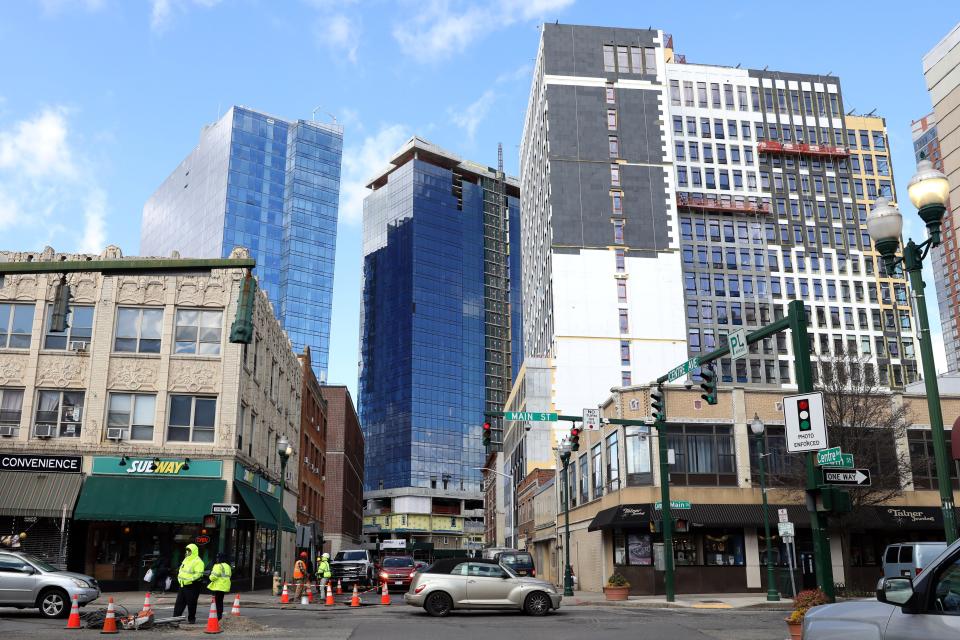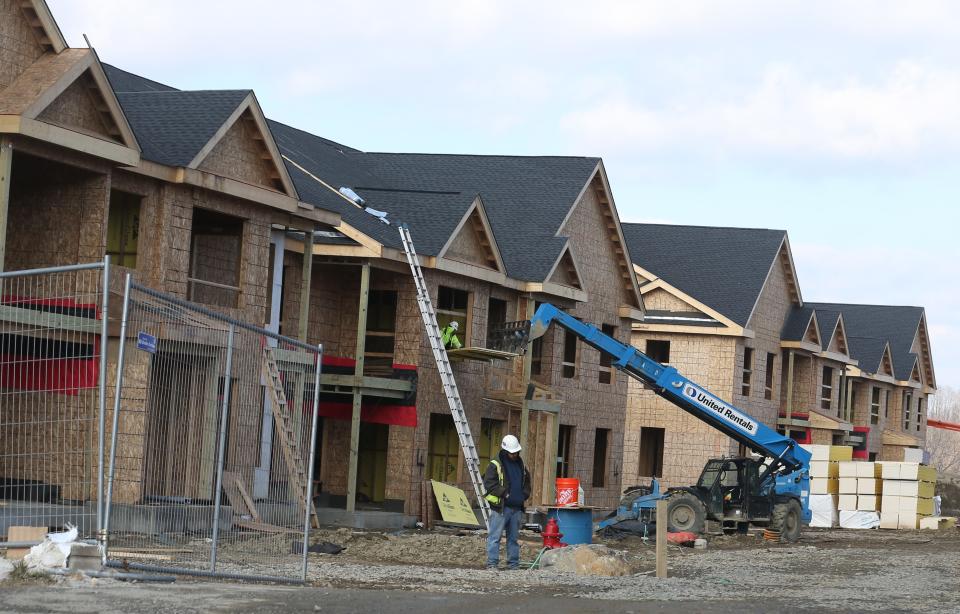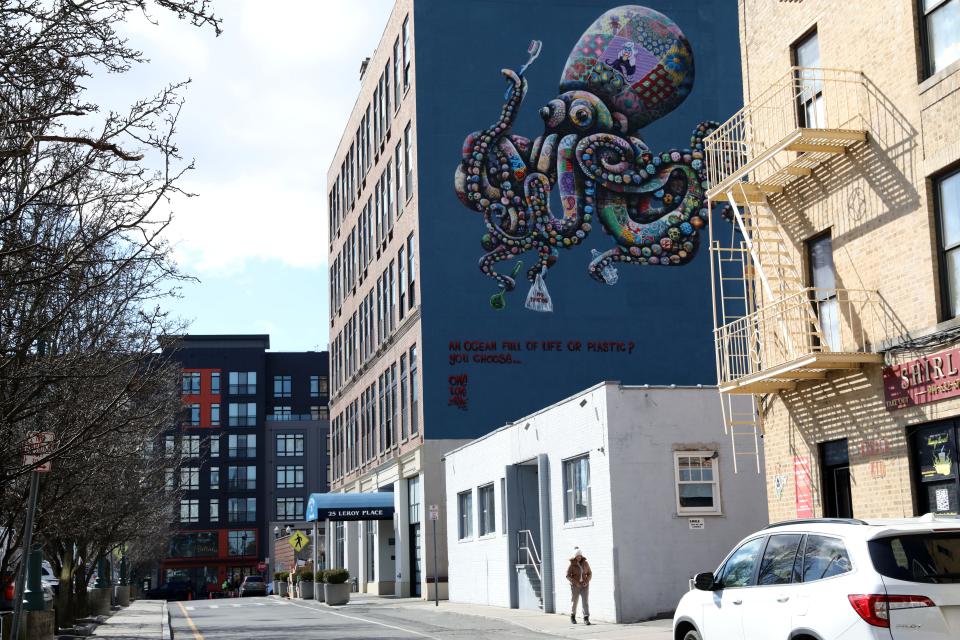NY housing data shows where growth is booming, stalling. Search our database
Housing shortage? You wouldn't know it from the raised skyline in downtown New Rochelle, where a trio of 28-story apartment towers built by a single developer has risen in the last few years.
They are just part of the recent growth. The booming Westchester County city approved nearly 4,000 new homes in all over the last 10 years, the second highest total of any municipality in the state outside New York City.
Similar bursts happened around the state in those years, scattered in far-flung corners. Rochester issued nearly 2,800 home-building permits from 2013 to 2022. Ithaca wrote almost 2,200. The densely populated village of Kiryas Joel in Orange County approved a whopping 3,500.

Those numbers are drawn from federal data Gov. Kathy Hochul's administration mined for her push to speed housing growth. That mission topped her agenda this year, cast as a vital step to tame spiraling rents and home prices that threaten to drive New Yorkers away and hobble the economy.
The USA Today Network compiled that state data showing housing permit trends from 2018 to 2022 into a database searchable by county, city, town and village. You can search it here: Data.lohud.com/new-york-housing-permits/
New York included the permit counts in a new state website that will track growth in each town, village and city. The permits paint an uneven picture of the Empire State — New homes are multiplying briskly in various spots, from Westchester to Monroe and Erie counties and to Long Island. But in many more places, including in those same counties, the pace has slowed to a trickle.
Thwarted plans: Hochul's housing push appears dead. Can suburbs solve affordability crisis on their own?
Cheering a Westchester County success story
The governor stood in a Westchester building lobby last week to notch a win for housing.
The setting was a new, 143-unit apartment complex with stores and a parking garage, built next to Harrison's Metro-North Railroad station. Twelve years in the making, it long predated her own push, but showed the sort of the transit-oriented development she wants to proliferate around train and subway stops in and around New York City.
"Just look out the window," she told a gathering of state and local officials and other guests. "This is what we're talking about. Showcasing what we can deliver, and how much New Yorkers lives can improve."

In her budget plans this year, Hochul had proposed requiring places with train stations to rezone around them for that type of project. But suburban lawmakers balked at that and another proposal to set mandatory growth targets for every municipality in the state. In the end, all housing plans were dropped from the budget.
Hochul vows to revisit those ideas in next year's legislative session. But in the meantime, she has launched the housing website and taken two steps on her own: giving municipalities that meet housing targets an edge in competing for state grants; and ordering a survey of state-owned properties to find suitable spots for new housing.
Where has housing growth has slowed in NY, and why?
Several Westchester places are among the state's housing growth leaders. Besides New Rochelle, there is Yonkers, which approved 3,800 new homes in the last decade, and White Plains, which approved almost 2,600, according to the state-provided data.
Harrison, host of the transit project that Hochul came to celebrate, issued about 1,500 housing permits. As the governor pointed out in her speech, last year's tally alone would increase the village's housing stock by 6% — six times the target rate she sought for the suburbs.
But growth has been much slower in other parts of the county, particularly in its less populated northern half and in built-out villages. The town of Bedford approved 63 homes in the last 10 years. North Salem issued only 19 permits. In Mount Kisco, the decade's total was just 10.
Growth targets: How many new homes must your town OK to meet NY Gov. Hochul's targets? Check our database
In an interview last week, Mount Kisco Mayor Gina Picinich said growth had been scarce because little undeveloped land remained in the village's three square miles. It already has a diverse housing mix, including multi-story apartment buildings, and is more densely populated than its neighbors, she said.
"We've been ahead of the curve, and this is why Mount Kisco is one of the more affordable places to live in northern Westchester," Picinich said.
She said village leaders updated Mount Kisco's zoning in 2019 to try to spur more housing, recognizing the shortage of options for young families, emergency workers, empty nesters and others. Among the changes: allowing homes above stores in the downtown area, townhouses in another, senior housing in yet another.
"We're just beginning to see the fruits of that," she said of the new zoning.
How some NY cities cleared the way for housing
Just a few towns over, Harrison is clearly having its moment.
Major projects there include the 736-unit Renaissance Harrison project, to be built on the site of a closed hotel, and the recently built Carraway complex, which consists of 421 luxury apartments.
"It's a place where people want to live," Harrison Mayor Rich Dionisio said to explain the recent housing boom. "I think the word has gotten out that we're a good community."
In New Rochelle, the recent growth is no mystery. Noam Bramson, who has been mayor since 2006, attributes the development surge largely to concerted steps the city took to steer housing to its downtown. Those plans forecast as many as 10,000 homes could result. Roughly 6,500 have already been built or approved.
What prompted those moves? Bramson said housing multiplied in the city in the late 90s and early 2000s, but stopped after the 2008 recession and never recovered.
"That really stalled out in the Great Recession," he said. "And we had a great deal of difficulty restarting that economic engine in New Rochelle."
Among the measures he and the council took were to rezone the downtown and to conduct environmental impact studies for the whole area, saving developers the expense and uncertainty of doing studies for each project.

Dozens of new apartment buildings sprung up as a result.
Bramson views that growth as a boon with multiple benefits for New Rochelle, from goosing the economy to making the downtown more culturally vibrant. He said he doesn't see housing as an obligation — or burden — that other Westchester places should do more to shoulder.
"I feel that towns and cities and villages that are resistant to growth are missing out," he said. "This is a great thing for communities that do it the right way."
Chris McKenna covers government and politics for The Journal News and USA Today Network. Reach him at cmckenna@gannett.com.
This article originally appeared on Rockland/Westchester Journal News: Where is NY building housing? Search database for town, city data

